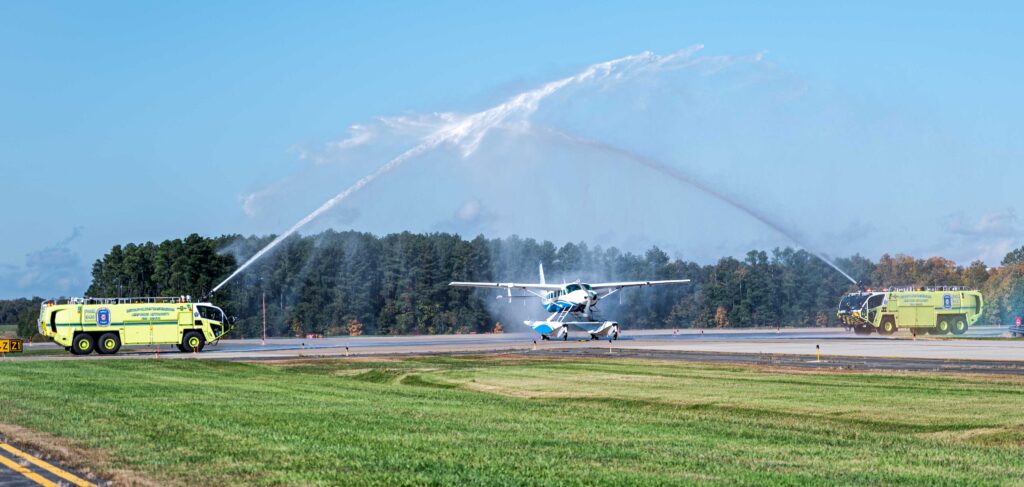Boarding a flight to New York straight from an oyster bar on the bank of Boston’s Charles River might not be your average air passenger experience. But it is precisely the sort of out-of-the-box thinking that Tailwind Air is banking on to carve a niche for itself in one of the United States’ most competitive markets.
The advent of the jet era and the drastic expansion of airport infrastructure led to the demise of seaplanes as a major form of air travel in the years that followed the Second World War.
However, Seaplanes never went away entirely, and continued to operate scheduled commercial air services in some niche markets, mostly serving remote and island communities.
But fast forward a few decades and with major airports becoming increasingly crowded and passengers facing all sorts of queues, checks, delays, and other inconveniences before they board their flights, some operators have turned to the sea (and rivers) for answers.
From downtown to downtown
Tailwind Air, a private aviation operator, has been operating seaplanes in the northeastern United States since 2014 but then, in 2021, decided to enter one of the country’s largest inter-city travel markets, linking Boston and New York.
Tailwind operates Cessna Caravan amphibian seaplanes able to carry eight passengers (plus two pilots), which are slower than the jets airlines traditionally use on this route. Tailwind, however, wants you to consider the total journey time, because this is where the seaplane has an edge.
Rather than using conventional airports in both cities, Tailwind’s flights take you from downtown to downtown. In New York that means Manhattan’s East River, while in Boston, Tailwind’s seaplanes use Fan Pier Marina on the Charles River.
In fact, time and convenience is one of the differentiating attributes of a service that, with prices ranging between $395 and $895 per person one-way, is certainly not within the budget category.
“Our flights take you from Manhattan to the Charles River in 75 minutes,” Peter Manice, Tailwind’s Co-Founder, and Director of Scheduled Services, told AeroTime. “If flying from New York-La Guardia (LGA) to Boston Logan (BOS), you are looking at 3.5 hours of total journey time once you include the time it takes you to get to the airport and to go through it.”
Weather conditions apply
There is a caveat, though, and that is the weather. One of the main drawbacks of seaplanes is that operations on water tend to be sensitive to weather conditions as seaplanes require a very flat water surface.
When weather conditions along the eastern seaboard make water-born operations unadvisable, Tailwind switches to alternative airports on land: Norwood airport (OWD) for Boston and Westchester County airport (HPN), near White Plains, in upstate New York, as an alternative to Manhattan’s seaplane terminal. According to Tailwind Air, around 8% of flights end up using diversionary airports.
Just in case, the service is seasonal, running between April and December and thus avoiding the majority of the winter months.
In this regard, Manice confirmed Tailwind had been looking at making the service year-round and possibly increasing capacity.
The airline executive stated that, while load factors had been relatively low at the start, demand had been picking up steadily.
“While our primary target are business travelers that commute frequently between the two cities and book their travel independently. Ours is a product that it is difficult to distribute through traditional channels like GDS, because, for a starter, we do not even use the typical airport codes people search for,” he explained.
“We have also seen a fair number of people travelling for leisure and other sorts of personal reasons,” he added.
Then there is, of course, the allure of trying something different and enjoying what could easily pass for a panoramic flight, with the final approaches of the seaplane providing breathtaking views of either Manhattan’s skyline or Boston’s downtown.
Tailwind has also taken care of things on the ground to make sure your trip is unlike a regular airport experience. While passengers departing Manhattan get to use the SkyPort lounge at 23rd Street, in Boston Tailwind uses part of the ReelHouse Oyster bar as a check-in venue, with a couple of tables reserved for passengers.
Tailwind has also launched two membership programs, Fast Lane Club (priced at $2,995 per year) and Fast Lane Club Plus (priced at $4,995 per year), which provide access to some heavily discounted inventory, with some flights priced at just $1. Although you will need to travel quite frequently to see a return on these annual membership fees.
In addition to the New York to Boston service, Tailwind services seaplane routes along the New England seaboard and, in 2022, launched a, so far short-lived, service between Manhattan and Washington DC. This route was not reinstated in Tailwind’s 2023 flight program, but Manice told AeroTime the airline is looking at options to restore it in spring 2024. However, he did not share any additional details.

Seaplane operations set to pioneer electric aviation
This type of small-scale operation, which avoids the largest and most congested hub airports, is poised to get a boost in the next few years if the new generation of hybrid-electric and electric regional aircraft currently under development make their market debuts. Whenever this happens, it is unlikely to take Tailwind by surprise.
In December 2022, Tailwind signed a letter of intent with Airflow, a Californian startup developing a hybrid-electric electric conventional take-off and landing (eCTOL) regional aircraft, a deal that later passed on to Electra.aero, another hybrid-electric aircraft developer, when it subsequently acquired Airflow.
The distributed electric propulsion that Electra.aero is developing is expected to significantly reduce operating costs for regional operators and may help airlines like Tailwind further spread their wings, whether on dry land or on water.

